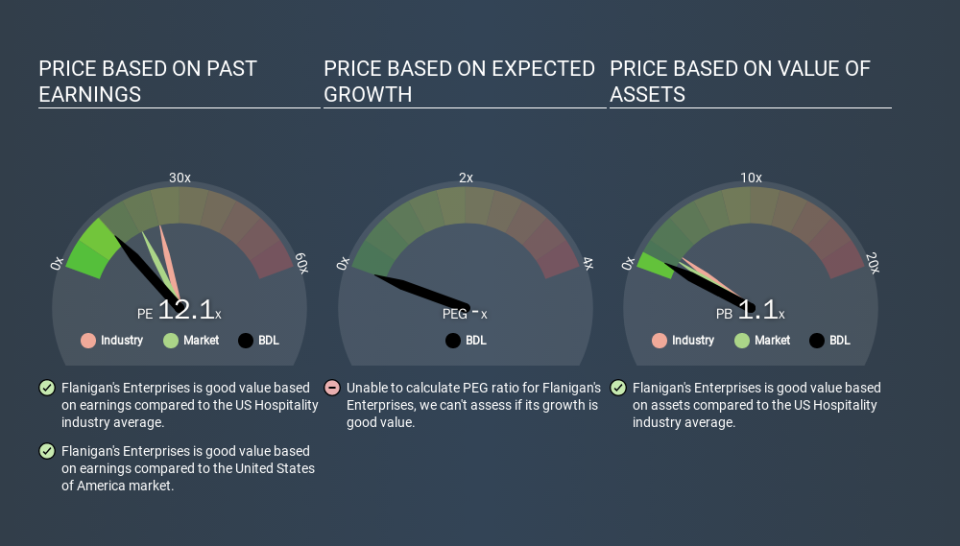Is Flanigan's Enterprises, Inc.'s (NYSEMKT:BDL) P/E Ratio Really That Good?

Unfortunately for some shareholders, the Flanigan's Enterprises (NYSEMKT:BDL) share price has dived in the last thirty days. The recent drop has obliterated the annual return, with the share price now down 13% over that longer period.
Assuming no other changes, a sharply higher share price makes a stock less attractive to potential buyers. While the market sentiment towards a stock is very changeable, in the long run, the share price will tend to move in the same direction as earnings per share. The implication here is that deep value investors might steer clear when expectations of a company are too high. One way to gauge market expectations of a stock is to look at its Price to Earnings Ratio (PE Ratio). A high P/E implies that investors have high expectations of what a company can achieve compared to a company with a low P/E ratio.
Check out our latest analysis for Flanigan's Enterprises
How Does Flanigan's Enterprises's P/E Ratio Compare To Its Peers?
We can tell from its P/E ratio of 12.10 that sentiment around Flanigan's Enterprises isn't particularly high. If you look at the image below, you can see Flanigan's Enterprises has a lower P/E than the average (24.2) in the hospitality industry classification.
Flanigan's Enterprises's P/E tells us that market participants think it will not fare as well as its peers in the same industry. Many investors like to buy stocks when the market is pessimistic about their prospects. It is arguably worth checking if insiders are buying shares, because that might imply they believe the stock is undervalued.
How Growth Rates Impact P/E Ratios
If earnings fall then in the future the 'E' will be lower. That means unless the share price falls, the P/E will increase in a few years. Then, a higher P/E might scare off shareholders, pushing the share price down.
Flanigan's Enterprises shrunk earnings per share by 5.0% last year. But it has grown its earnings per share by 5.8% per year over the last five years.
Remember: P/E Ratios Don't Consider The Balance Sheet
The 'Price' in P/E reflects the market capitalization of the company. So it won't reflect the advantage of cash, or disadvantage of debt. The exact same company would hypothetically deserve a higher P/E ratio if it had a strong balance sheet, than if it had a weak one with lots of debt, because a cashed up company can spend on growth.
Such expenditure might be good or bad, in the long term, but the point here is that the balance sheet is not reflected by this ratio.
So What Does Flanigan's Enterprises's Balance Sheet Tell Us?
Net debt totals just 3.2% of Flanigan's Enterprises's market cap. So it doesn't have as many options as it would with net cash, but its debt would not have much of an impact on its P/E ratio.
The Bottom Line On Flanigan's Enterprises's P/E Ratio
Flanigan's Enterprises's P/E is 12.1 which is below average (18.9) in the US market. Since it only carries a modest debt load, it's likely the low expectations implied by the P/E ratio arise from the lack of recent earnings growth. What can be absolutely certain is that the market has become less optimistic about Flanigan's Enterprises over the last month, with the P/E ratio falling from 12.1 back then to 12.1 today. For those who don't like to trade against momentum, that could be a warning sign, but a contrarian investor might want to take a closer look.
Investors have an opportunity when market expectations about a stock are wrong. If it is underestimating a company, investors can make money by buying and holding the shares until the market corrects itself. Although we don't have analyst forecasts shareholders might want to examine this detailed historical graph of earnings, revenue and cash flow.
You might be able to find a better buy than Flanigan's Enterprises. If you want a selection of possible winners, check out this free list of interesting companies that trade on a P/E below 20 (but have proven they can grow earnings).
If you spot an error that warrants correction, please contact the editor at editorial-team@simplywallst.com. This article by Simply Wall St is general in nature. It does not constitute a recommendation to buy or sell any stock, and does not take account of your objectives, or your financial situation. Simply Wall St has no position in the stocks mentioned.
We aim to bring you long-term focused research analysis driven by fundamental data. Note that our analysis may not factor in the latest price-sensitive company announcements or qualitative material. Thank you for reading.

